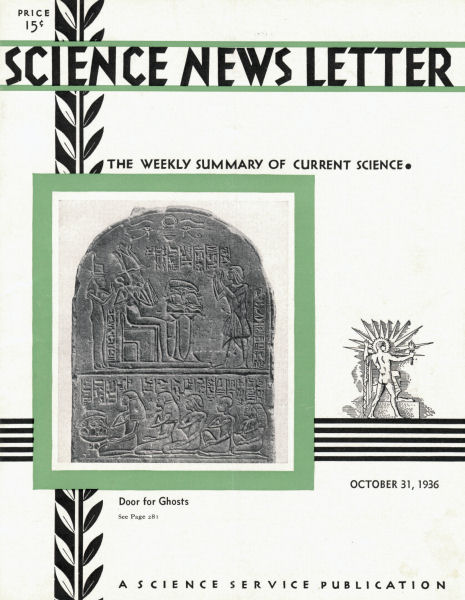From the October 31, 1936, issue

TOMBSTONE PROPER EXIT FOR THE HALLOWE’EN SPIRITS
If you see a Hallowe’en ghost rising spookily from behind a tombstone in ye olde graveyard, night of Oct. 31, don’t laugh.
For tombstones are the proper and conventional exit doors for spirits. No less authorities than the ancient Egyptians established that point of behavior thousands of years ago.
A tombstone is merely a door with the house missing. So it appears from study of Egypt’s ancient arrangements for life in the spirit world.
At the Field Museum of Natural History, Dr. T. George Allen has just completed a study of the stelae—stone monuments—that the museum has obtained from Egypt. Most of them are tombstones, decorated with scenes once painted in red, blue, black, yellow, and brown of Egyptian art, and bearing names, prayers, and religious thoughts.
Two ideas blended, it appears, to produce the invention of tombstones: an inscription and a spirit door.
Kings of Egypt from the first dynasty, almost 3400 B.C., had round-topped stelae—the familiar tombstone shape—included in their simple tombs, with inscriptions on them.
Then came the age of giant pyramid tombs for Egypt’s kings. The pharaohs who planned their pyramids with keenest interest included in the rooms a place or places where the faithful living could go to put offerings for the dead. These offerings, Dr. Allen explains, would be deposited on an offering-table and let down into the ground before a niche inscribed under the owner’s name and titles. And the niche was so shaped that archaeologists call it a “false door.” For through this fake doorway, never intended to swing open to human touch, the spirits of the dead kings were supposed to pass when they returned from the realm of the dead to eat and enjoy the offerings.
Later in Egypt, the common man copied kings and began to provide cautiously for his own welfare in the future world.
“His tomb was relatively small and simple,” says Dr. Allen. “But the false door of the Old Kingdom had survived in the guise of a tombstone or stela set up to mark his resting place.”
TO VOTERS THERE IS MUCH IN A POLITICAL PARTY NAME
Voters who go to the polls next Tuesday may be casting their ballots for a party name that they like instead of for the policies that they approve.
House-to-house interviews with voters in an agricultural county in Pennsylvania revealed that there, at least, individuals may be violently opposed to a party and yet be in favor of its principal planks. Actually, the voters interviewed were in favor of worker ownership of industries, reduction of huge fortunes, government ownership of railroads, government old-age insurance, and the other typical policies of the Socialist party. But they prefer the Republican party!
The results of this canvass of voters are just made public by Dr. George W. Hartmann of Teachers’ College, Columbia University, who made the study, in a report to the current issue of the Journal of Social Psychology (August).
The voters interviewed indicated their preference for a group of 22 political party names, including, along with the principal parties in next week’s election, several names that were fictitious or belonging to obsolete parties. The old-line parties, Republican and Democratic, led in preference, as might be expected. But Farmer-Labor was also high in popularity although a party with this name has never had any candidates in the region where the canvass was made. Labor party and Workers’ party were next in order of preference, and they were followed by Socialist. At the very bottom stood Technocratic and Communist.
STARVATION RECORD SET AS TICKS SURVIVE FOR 5 YEARS
A starvation record has fallen as 12 Texas ticks got their first meal in 5 years—blood sucked from a monkey.
A record for longevity in the tick world was broken at the same time in the laboratories of Dr. Edward Francis of the U.S. Public Health Service’s National Institute of Health, where the ticks dwell in little wooden boxes that look like apartment houses set on sand.
The starvation and longevity records have interest to others than just scientists, however: They are an unpleasant menace to the longevity of man.
These ticks harbor the germ of relapsing fever, a disease with symptoms something like those of malaria and with a 50 percent mortality in some parts of the world. There have been 250 cases of this disease in Texas in the last 6 years, none of them fatal, however.
The ticks are not the ordinary wood ticks but belong to the species Ornithodorus turicata and are found only in Texas, Arizona, California, and Colorado.
The amazing thing about these ticks is the length of time they can go without a meal. Twelve of them have lived for the past 5 years without any food at all. Not only that, but these ticks on their diet of what Dr. Francis terms “thin air” have been able to nourish in their starved bodies the spiral germs that cause relapsing fever.







